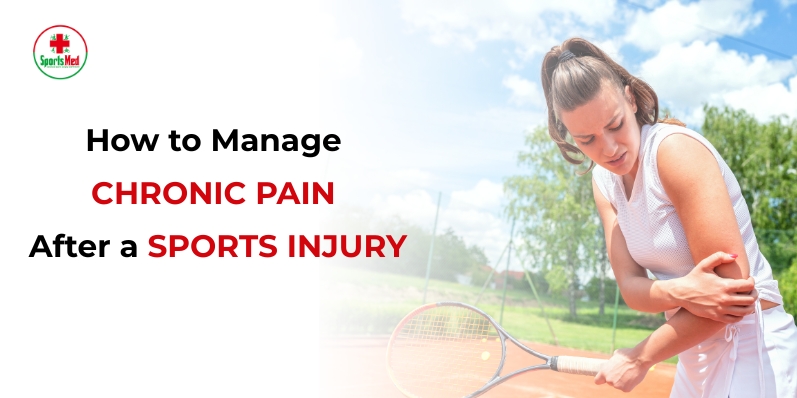
How to Manage Chronic Pain After a Sports Injury
Sports injuries range from a slight strain to a severe ligament tear. Pain persists for some people even after injuries are supposed to have healed. Pain lasting weeks to months after the so-called healing period is considered chronic pain. Despite exercise, sleep, and mood being all affected by chronic pain, an injured athlete can somehow suffer from it. With proper treatment and management, however, the pain could become much more bearable. This blog discusses the types of chronic pain, how to identify them, and how to manage them, primarily for athletes and active individuals.
What Is Chronic Pain?
Chronic pain is pain that lasts for more than three months or beyond the normal period of healing. While acute pain is a signal or warning of present injury, chronic pain outlives tissue healing. This process may occur through alterations in the nervous system or unresolved inflammation.
Chronic pain following a sports injury can have several reasons:
● Owing to improper or delayed treatment of the original injury
● Repeated strain or overuse
● Nerve injury
● Adhesion or scar tissue accumulation
● Psychological aspects, such as psychiatric disorders or depression
The IASP estimates that about 20 percent of adults throughout the world suffer from chronic pain, an occurrence to which athletes become quite prone when injuries are not adequately managed.
Signs You Are Dealing With Chronic Pain
Early diagnosis of chronic pain can go a long way in preventing further complications. Some signs that are common in chronic pain include:
● Pain that persists for longer than 12 weeks after the injury
● Stiffness and reduced range of motion in the affected area
● Swelling that may not resolve entirely
● Tingling sensations or numbness, especially if the nerves are affected
● Fatigue or sleep disturbances
● Irritability, anxiety, or depression, since pain is continuous
You should get in touch with a sports injury expert for evaluation, and then proceed with the development of an adequate treatment plan should you experience any of the above symptoms. The Sports Injury Care facility offers expert assessment and tailored solutions for your long-term pain management.
Practical Strategies to Manage Chronic Pain
Chronic pain calls for multidisciplinary approaches involving physical and psychological treatments in addition to medical attention. In line with the most effective therapies, here are some treatment methods:
1. Physical Therapy
Custom physical therapy is the best way to handle chronic pain arising from sports injuries. Physiotherapists work on:
● Stretching and strengthening exercises
● Manual therapy and soft tissue release
● Posture correction, along with improving joint mobility
Around 70% of chronic musculoskeletal pain cases report a significant improvement after regular physiotherapy. Licensed physiotherapists at Sports Injury Care tailor programs to match the individual condition and patient goals.
2. Painkillers (Under Medical Supervision)
Most often, pain interferes with the daily routine, and so short-term medicine use is allowed:
● NSAIDs like ibuprofen can reduce inflammation.
● Muscle relaxants decrease stiffness.
● Topical creams and patches are good alternatives.
Use these treatments cautiously, preferably under the guidance of a sports medicine doctor, to avoid the uncertainty of dependence or worse side effects.
3. Alternative Therapies
Patients find complementary approaches helpful in pain relief. They include:
● Dry needling or acupuncture
● Ultrasound therapy
● Transcutaneous electrical nerve stimulation (TENS)
● Kinesiology tapes
All are noninvasive; they offer pain relief while healing interstitially.
4. Mind-Body Practices
Chronic pain is stressful for the body as well as the mind. Those disciplinary methods include:
● Cognitive behavioral therapy (CBT)
● Mindfulness meditation
● Yoga or guided stretching
Also, it helps patients to lower the reported intensity of pain and raise the quality of life. The National Institutes of Health (NIH) says that CBT in combination with physical rehabilitation helps 60-80% of persons suffering from chronic pain.
5. Lifestyle Changes
Lifestyle changes can be pretty helpful in symptom relief:
● The patient needs to be on an anti-inflammatory diet.
● Very slight exercise is encouraged, such as swimming or walking.
● Avoidism is a good thing. Heavy drinking and smoking are just the two things that sit and worsen chronic pain.
All these behaviors help prevent pain flare-ups and facilitate the tissue's healing from within.
Conclusion
In conclusion, chronic pain can cause pressure on or irritation of nerves and mental agony, and it is not without reason that the term 'chronic' holds the whole life of its sufferer. Properly treated, chronic pain can be eased through a combination of good medical care, physical therapy, lifestyle changes, and counseling. Suppose anyone in your family has been battling chronic pain for some time due to an old injury. In which case, the time to act is now. Contact our highly trained and knowledgeable staff at Sports Injury Care, who understand pain and recovery behind the scenes. With early intervention and treatment options tailored to your unique needs, you will be comfortable and confident in returning to an independent life.